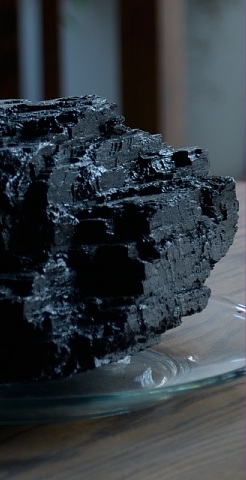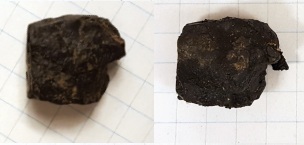book review
The Chemistry and Technology of Coal, 3e
by James G. Speight
CRC 2013 / 2016 (paperback), 819 pages
Reviewed by T.J. Nelson
 oal mining has historically been one of the most dangerous occupations. Coal mines
have to be pre-drilled to release methane, which would otherwise blast out
at high pressure. There are vast amounts of highly compressed carbon dioxide,
sometimes hydrogen sulfide and, after an explosion or fire, carbon monoxide.
Underground coal fires, which are very difficult to put out, can burn for years.
But by far the biggest hazard is the highly explosive coal dust itself. James Speight
says in the 20th century over 100,000 coal miners lost their lives in workplace
accidents, cave-ins, and explosions.
oal mining has historically been one of the most dangerous occupations. Coal mines
have to be pre-drilled to release methane, which would otherwise blast out
at high pressure. There are vast amounts of highly compressed carbon dioxide,
sometimes hydrogen sulfide and, after an explosion or fire, carbon monoxide.
Underground coal fires, which are very difficult to put out, can burn for years.
But by far the biggest hazard is the highly explosive coal dust itself. James Speight
says in the 20th century over 100,000 coal miners lost their lives in workplace
accidents, cave-ins, and explosions.

Bituminous coal specimen found in my back yard
But isn't coal coal? No! Speight tells us there are many ranks, types, and grades of coal. Ranks include the familiar anthracite, bituminous, subbituminous, and lignite. Types are the organic parts of coal, called macerals, which are the coal equivalents of minerals that make up rocks. They fall into three categories: vitrinite, inertinite, and exinite or liptinite. Petrologists classify these further into subgroups like fusinite, micrinite, alginite, resinite, cutinite, sporinite, and fluorinite, depending on what part of the plant they came from. And then there are many, many different grades, which are distinguished by how much inorganic stuff is in the coal.
Run-of-mine or ROM coal, which is what actually comes out of the mine, according to Speight, contains 60% reject materials like car wheels, chunks of rock that fell from the ceiling, timber, shot wires, and cutting bits. In the old days, kids were paid to stand by conveyor belts and pick this stuff out.
Coal doesn't have a fixed chemical structure. It's generally regarded as a layered complex of polycyclic aromatic hydrocarbons containing carboxylate groups, ethers, etc., similar to humic acids, with entangled networks of organic crosslinks. Much of it consists of free phenolic compounds that are easily extracted by organic solvents. When heated, coal becomes plastic, then rapidly rearranges via free radical reactions into coke, a lightweight, porous material used in steel mills. Pieces of coke can still be found along railroad tracks throughout the rust belt.
Even though bituminous coal is considered a sedimentary rock (the more carbon-rich anthracite being a metamorphic rock), Speight says coal can be completely dissolved in solvents like tetralin (1,2,3,4-tetrahydronaphthalene) and it swells to twice its size in pyridine, and many papers in the literature confirm it.
I still found that a little hard to believe, so I picked up a little piece of coal from my back yard and took it into the lab. After three days soaking in pyridine it had scarcely changed (see photo). Maybe my coal is defective in some way, or maybe different kinds of coal behave differently. However, the pyridine did turn into a dark orange soup, which means it extracted many organic compounds from the coal.

Coal soaked in pyridine for three days at room temperature. Left= before, Right= after. Maybe just a tad bigger
Pre-war German chemists knew this very well, and there's a huge chemistry literature of coal products that led to dyes and pharmaceuticals that's still valuable today.
Coal also contains nitrogen, sulfur, oxygen, and trace metals that were in the original plants. About 2/3 of the sulfur is in the form of sulfides such as pyrites (FeS2), marcasite (FeS2), galena (PbS), and sphalerite (ZnS). They're important: washing coal with water promotes oxidation of the sulfides to sulfates which causes coal to break into smaller pieces. This creates the dreaded coal dust which, if it doesn't explode, undergoes spontaneous combustion at only 122°F. Lower grade coal can spontaneously combust at temperatures as low as 104°F (40°C). Great skill and care go into making those casual-looking piles of coal.
Of course it's coal liquefaction and gasification that are of interest today. The Germans did a lot of liquefaction during the war, and the British used the exothermic reaction C + H2O → CO + H2 to produce a fuel gas. This deadly mixture, containing up to 10% carbon monoxide, is nowadays called synthesis gas, but at one time it was actually piped into people's homes. Hence the image of committing suicide by putting one's head in an oven.
Coal liquefaction and gasification get over 100 pages. The Fischer-Tropsch synthesis, which converts coal into liquid hydrocarbons, is being used in some countries today. Many other methods are described, along with process diagrams, though it's hard to compare them; high efficiency seems to be only attainable when hydrogen is added. A problem with Fischer-Tropsch is that the product is mostly unbranched, which means low octane number (about 40). So it appears to be a field with many opportunities for innovation. On the other hand, methanol is ideal for fuel cells, and good processes exist for converting coal to methanol. Coal costs more to transport than to mine, so converting it to a liquid or especially gases like hydrogen, which are easier to clean (e.g. by scrubbing) than liquids, makes a lot of sense.
Next are chapters on clean coal technologies and environmental issues like subsidence, mine water, and land reclamation. Has a glossary and many diagrams and low-quality grayscale illustrations.
Coal's name is mud at the moment. But give liberals free-range coal, each piece carefully hand-picked by carefully selected legality-challenged immigrants, hand-cleaned to remove the iron sulfide crystals, rocks, and speckles of blood that cling to the outer surface, charge them ten bucks apiece for it, and it will undoubtedly become wildly popular again.

